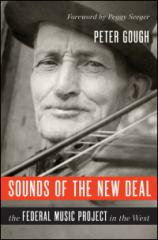Sounds of the New Deal: The Federal Music Project in the West
Review
Sounds of the New Deal: The Federal Music Project in the West
History lecturer Peter Gough has researched the effects of the New Deal in its outreach to musicians in the American West during the Great Depression.
The programs instituted by Franklin and Eleanor Roosevelt to try to pull Americans out of the economic doldrums of the Great Depression reflected some of our national interests and biases --- and proved our willingness to change. Initially targeting musicians of the classical genres --- symphonic, orchestral --- the Federal Music Project (FMP) gradually took on a new tone when the project’s director, Dr. Nikolai Sokoloff, a former conductor of the Cleveland Orchestra and a strict traditionalist, found an assistant in musicologist Charles Seeger, who, though he venerated classical forms, expanded the reach of the agency to include folk music. Seeger’s daughter, noted folk singer/songwriter Peggy Seeger, has provided an introduction to Gough’s examination of how these policies played out in the Western states.
"Gough’s research reveals a change in American acceptance of its own heritage through the auspices of the FMP, and underscore the permanent influence of some purely Western strains of music that are now thoroughly --- and proudly --- considered part of our national brand."
In the West, unlike eastern and southern regions of the US, the ethos had always been one of change, invoking the pioneering spirit. This included labor movements and leftward political leanings. But as fascism bore down in Europe and war was imminent, even the political proletariat began to move towards centrism, and to embrace popular trends that might bring more people into the anti-fascist fold. Musically, that meant a resurgence of interest in Hispanic and African American forms and a new look at old music like square dance, fiddle tunes, and the sounds of the banjo, an instrument that had moved beyond the racial divide.
An African American choral group, the Carlyle Scott Chorus, astounded its Los Angeles audience by being the first such grouping to present Handel’s Messiah, providing a true fusion of musical cultures. Hawaiian music grew in popularity. Cowboy or “hillbilly” ditties like “Home on the Range” and “She’ll Be Coming ’Round the Mountain” made a lasting impression on schoolchildren of the era. A Spanish songbook was produced and distributed. The elitist notion of music as produced by the few for the enjoyment of the wealthy was transformed when Seeger insisted on entertaining visiting foreign dignitaries with folk musicians, including a square dance troupe. Songs of the people began to be seen as having a culturally and racially unifying effect as they spread through school classes, and women’s issues were addressed when the FMP engaged the first female conductor of a symphony orchestra in the US, Antonia Brico.
Gough’s research reveals a change in American acceptance of its own heritage through the auspices of the FMP, and underscore the permanent influence of some purely Western strains of music that are now thoroughly --- and proudly --- considered part of our national brand.
Reviewed by Barbara Bamberger Scott on March 2, 2018
Sounds of the New Deal: The Federal Music Project in the West
- Publication Date: February 5, 2018
- Genres: History, Music, Nonfiction
- Paperback: 304 pages
- Publisher: University of Illinois Press
- ISBN-10: 0252083490
- ISBN-13: 9780252083495



